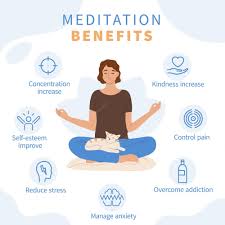In today’s fast-paced and demanding world, stress has become an all-too-common companion for many people. The constant pressures of work, relationships, and daily responsibilities can leave us feeling overwhelmed and exhausted. Fortunately, there is a powerful tool that can help us find calm amidst the chaos: meditation.
Meditation is a practice that has been around for thousands of years and is rooted in ancient traditions such as Buddhism and Hinduism. However, its benefits are not limited to any particular belief system or religion. It is a universal practice that can be embraced by anyone seeking relief from stress and a greater sense of well-being.
So, how does meditation help with stress? At its core, meditation is about training the mind to focus on the present moment and cultivating a state of inner peace and clarity. By bringing our attention to the present moment, we can let go of worries about the past or future that contribute to our stress levels.
One of the most significant benefits of meditation is its ability to activate the relaxation response in our bodies. When we experience stress, our bodies go into fight-or-flight mode, releasing stress hormones like cortisol. This response served us well in ancient times when we needed to escape from physical threats. However, in modern life, this constant activation of the stress response can have detrimental effects on our health.
Meditation helps counteract this by activating the opposite response known as the relaxation response. During meditation, our heart rate slows down, blood pressure decreases, and muscle tension eases. This physiological shift allows our bodies to enter a state of deep relaxation where healing and rejuvenation can occur.
Moreover, regular meditation practice enhances our ability to manage stressful situations more effectively. It helps us develop resilience by cultivating awareness and acceptance of our thoughts and emotions without judgment. Through this process, we learn to respond rather than react impulsively to stressful triggers.
There are various meditation techniques one can explore to alleviate stress. Mindfulness meditation, for example, involves paying attention to the present moment without judgment. It can be as simple as focusing on your breath or observing sensations in your body. Guided meditation, on the other hand, involves following the instructions of a recorded voice that leads you through relaxation exercises and visualizations.
Incorporating meditation into your daily routine doesn’t have to be time-consuming or complicated. Even just a few minutes of practice each day can make a significant difference in managing stress levels. Find a quiet space where you can sit comfortably, close your eyes, and bring your attention to your breath or a chosen point of focus. Allow yourself to let go of thoughts and worries as they arise, gently bringing your attention back to the present moment.
As with any skill, consistency is key. The more you practice meditation, the more profound its effects become. Over time, you’ll notice that you become better equipped to handle stressors with calmness and clarity.
In conclusion, meditation is a powerful tool for managing stress in our hectic modern lives. By cultivating mindfulness and relaxation through regular practice, we can find solace amidst the chaos and improve our overall well-being. Give yourself the gift of inner peace by incorporating meditation into your daily routine—you won’t regret it.
6 Tips for Stress-Relieving Meditation: Creating a Calming Practice
- Find a comfortable place to sit
- Set an intention
- Start with deep breathing
- Allow thoughts to come & go
- Be gentle with yourself
- End with gratitude
Find a comfortable place to sit
When it comes to meditation for stress relief, finding a comfortable place to sit is essential. Creating a serene and supportive environment can greatly enhance your meditation experience and help you find a sense of calm.
First and foremost, choose a quiet space where you can sit without distractions. It could be a corner of your home, a peaceful park bench, or even a dedicated meditation room if you have one. The key is to find a place where you feel at ease and can focus without interruptions.
Next, consider your seating arrangement. Find a chair or cushion that provides adequate support for your body. You want to ensure that your spine is aligned and upright, allowing for easy breathing and relaxation. If sitting cross-legged on the floor is uncomfortable, using props like pillows or bolsters can help create the right posture for you.
Once you’ve found your spot and settled into your seat, take a moment to adjust any tight clothing or remove any accessories that may restrict your comfort during meditation. Loosen your belt, take off your shoes if possible, and make sure you’re wearing clothing that allows for unrestricted movement.
Remember that comfort is subjective, so it’s important to listen to your body’s needs. If sitting in one position becomes uncomfortable after some time, give yourself permission to adjust or shift positions gently without judgment.
Creating an inviting atmosphere in your meditation space can also contribute to relaxation. Consider adding elements like soft lighting, calming scents such as incense or essential oils, or even playing gentle background music if it helps create an ambiance that supports tranquility.
By finding a comfortable place to sit during meditation, you set the stage for deepening relaxation and reducing stress levels. Remember that this practice is about creating an environment conducive to inner peace and well-being. So take the time to set up your space thoughtfully—it will make all the difference in cultivating a successful meditation practice for stress relief.
Set an intention
When it comes to meditation for stress relief, setting an intention can be a valuable tool to enhance your practice. An intention is like a guiding principle or focus that helps direct your attention and energy during your meditation session.
Setting an intention before you begin your meditation practice can provide clarity and purpose. It allows you to align your thoughts and actions with what you hope to achieve or experience during your meditation. This simple act of setting an intention can have a profound impact on reducing stress and enhancing the benefits of your practice.
To set an intention for your meditation, start by reflecting on what you need in that particular moment. Is it peace, calmness, clarity, or perhaps self-compassion? Identify the quality or feeling that resonates with you the most.
Once you have identified your intention, repeat it silently to yourself or write it down. You can also visualize or imagine embodying that intention throughout your meditation. Allow it to become the focal point of your attention as you settle into your practice.
By setting an intention, you create a mental anchor that helps bring you back to the present moment when distractions arise. It serves as a gentle reminder of why you are meditating and what you hope to cultivate within yourself.
Setting an intention doesn’t mean striving for perfection or forcing yourself into a particular state of mind. Instead, it is about creating an inner compass that guides and supports you as you navigate through the waves of thoughts and emotions during meditation.
Whether it’s finding peace amidst chaos, cultivating self-compassion in times of stress, or simply seeking a moment of stillness, setting an intention can help deepen your meditation practice and enhance its stress-relieving benefits.
Remember that intentions can evolve and change from one session to another based on what feels most relevant in the present moment. Be open to exploring different intentions and allow yourself the freedom to adapt them as needed.
So, next time you sit down for a meditation session, take a moment to set an intention. Embrace the power of this simple yet transformative practice and watch as it brings focus, clarity, and a greater sense of peace to your meditation for stress relief.
Start with deep breathing
When it comes to managing stress, one of the simplest yet most effective techniques is to start with deep breathing. Deep breathing is a foundational practice in meditation that helps us calm our minds and relax our bodies.
When we are stressed, our breathing tends to become shallow and rapid, further exacerbating our feelings of tension. By consciously focusing on deep breaths, we can counteract this stress response and bring ourselves back to a state of balance.
To start, find a quiet and comfortable place where you can sit or lie down. Close your eyes and take a moment to settle into the present moment. Begin by inhaling slowly through your nose, allowing the breath to fill your abdomen, expanding it like a balloon. Feel the breath travel all the way down into your belly.
As you exhale through your mouth, imagine releasing all the tension and worries from your body. Let go of any thoughts or distractions as you continue this rhythmic pattern of deep breathing.
Deep breathing not only helps us relax physically but also has a direct impact on our nervous system. It stimulates the parasympathetic nervous system, which is responsible for promoting relaxation and reducing stress.
By incorporating deep breathing into your daily routine, you can create moments of calm amidst the chaos of daily life. You can practice it anytime and anywhere – during breaks at work, before important meetings or presentations, or even when you’re feeling overwhelmed in the midst of a busy day.
Remember that consistency is key. The more frequently you engage in deep breathing exercises, the more natural it becomes for your body and mind to relax in response to this intentional act.
So next time you find yourself feeling stressed or anxious, take a pause and start with deep breathing. Allow its soothing rhythm to wash over you as you reconnect with yourself in the present moment. Embrace this simple yet powerful technique as an essential tool in your journey towards managing stress and finding inner peace.
Allow thoughts to come & go
When it comes to meditation for stress, one valuable tip is to allow thoughts to come and go. In our busy lives, our minds are constantly bombarded with thoughts, worries, and distractions. During meditation, it’s natural for these thoughts to arise. However, instead of getting caught up in them or trying to suppress them, the key is to observe them without judgment and let them pass.
By allowing thoughts to come and go during meditation, we create a space of non-attachment. This practice helps us develop a sense of detachment from our thoughts and emotions, allowing us to experience a greater sense of inner peace and calm.
Imagine sitting by a peaceful riverbank and watching leaves float by on the water. Instead of reaching out and grabbing each leaf or getting frustrated that they keep appearing, you simply observe them as they pass by. Similarly, during meditation, we can view our thoughts as passing leaves on the river—acknowledge their presence but let them flow away without clinging onto them.
This practice has several benefits for managing stress. First, it allows us to cultivate a sense of mindfulness—the ability to be fully present in the moment—by redirecting our focus back to our breath or chosen point of focus whenever thoughts arise. This helps break the cycle of rumination and worry that often contributes to stress.
Secondly, allowing thoughts to come and go helps us develop resilience in the face of stressors. By observing our thoughts without judgment or attachment, we gain clarity on what truly matters and what is merely passing mental chatter. This awareness empowers us to respond more skillfully rather than react impulsively when faced with stressful situations.
Lastly, this practice fosters self-compassion. It reminds us that we are not defined by our thoughts or emotions but rather by our ability to observe them with kindness and acceptance. By letting go of self-criticism or judgment during meditation, we create space for self-love and understanding, which can be immensely healing in times of stress.
Remember, meditation is not about achieving a thought-free state but rather about developing a healthy relationship with our thoughts. By allowing thoughts to come and go without getting entangled in them, we cultivate a sense of inner freedom and spaciousness.
So, the next time you sit down to meditate, embrace the practice of allowing thoughts to come and go. Observe them with curiosity and gentleness, knowing that they are simply passing through. By doing so, you’ll discover a greater sense of peace and resilience in the face of stress—a true gift that meditation offers.
Be gentle with yourself
When it comes to meditation for stress relief, one crucial tip to remember is to be gentle with yourself. In our fast-paced society, we often push ourselves to achieve more and expect instant results. However, meditation is not about striving or forcing outcomes; it’s about creating a space of compassion and acceptance.
Stress can make us feel overwhelmed and critical of ourselves. We might judge our thoughts as distractions or become frustrated when we can’t immediately quiet our minds. But in reality, meditation is a practice that requires patience and self-kindness.
Being gentle with yourself during meditation means acknowledging that thoughts will arise, and that’s perfectly normal. Instead of getting caught up in self-judgment or frustration, gently bring your attention back to your breath or chosen point of focus. Treat yourself with kindness by recognizing that the mind naturally wanders and gently guiding it back without harsh criticism.
It’s also important to let go of any expectations or judgments about how your meditation practice should be. Each session will be unique, and some days may feel more challenging than others. Embrace these variations without judgment or self-criticism.
Remember that meditation is not a performance; it’s an opportunity for self-care and inner exploration. Allow yourself the space to simply be present with whatever arises during your practice—whether it’s calmness, restlessness, joy, or even stress itself.
By cultivating gentleness in your meditation practice, you extend that same kindness towards yourself outside of your sessions as well. You develop a greater sense of self-compassion and understanding, which can help alleviate stress in all areas of your life.
So, as you embark on your journey of using meditation for stress relief, remember this valuable tip: be gentle with yourself. Embrace each moment with kindness and non-judgmental awareness. Through this approach, you’ll create a nurturing environment for relaxation, healing, and personal growth.
End with gratitude
When it comes to managing stress, meditation is a valuable practice that can bring peace and clarity to our minds. And one powerful way to enhance the benefits of meditation is by ending each session with gratitude.
Gratitude is a practice of acknowledging and appreciating the positive aspects of our lives. It shifts our focus from what’s wrong or stressful to what we are grateful for, creating a sense of contentment and joy. When we combine meditation with gratitude, we amplify the positive effects on our well-being.
As you near the end of your meditation session, take a few moments to reflect on the things you are grateful for. It could be something as simple as a beautiful sunrise, a supportive friend, or good health. Allow yourself to genuinely feel appreciation for these blessings.
Practicing gratitude at the end of your meditation helps shift your mindset from stress and worry to one of abundance and positivity. It reminds you that even in challenging times, there are still things to be thankful for. This perspective can bring about a sense of peace and calm that lingers long after your meditation session ends.
Incorporating gratitude into your meditation practice doesn’t have to be complicated. You can simply mentally list three things you’re grateful for or keep a gratitude journal where you write them down daily. The key is consistency and sincerity.
By ending your meditation with gratitude, you infuse your mind with positive energy and set yourself up for a more peaceful day ahead. So, take a moment each day to express thanks for the blessings in your life—it’s an incredible way to cultivate joy and reduce stress levels.
Remember, stress may be inevitable in life, but with the power of meditation and gratitude combined, you have the tools to navigate through it with grace and resilience.



